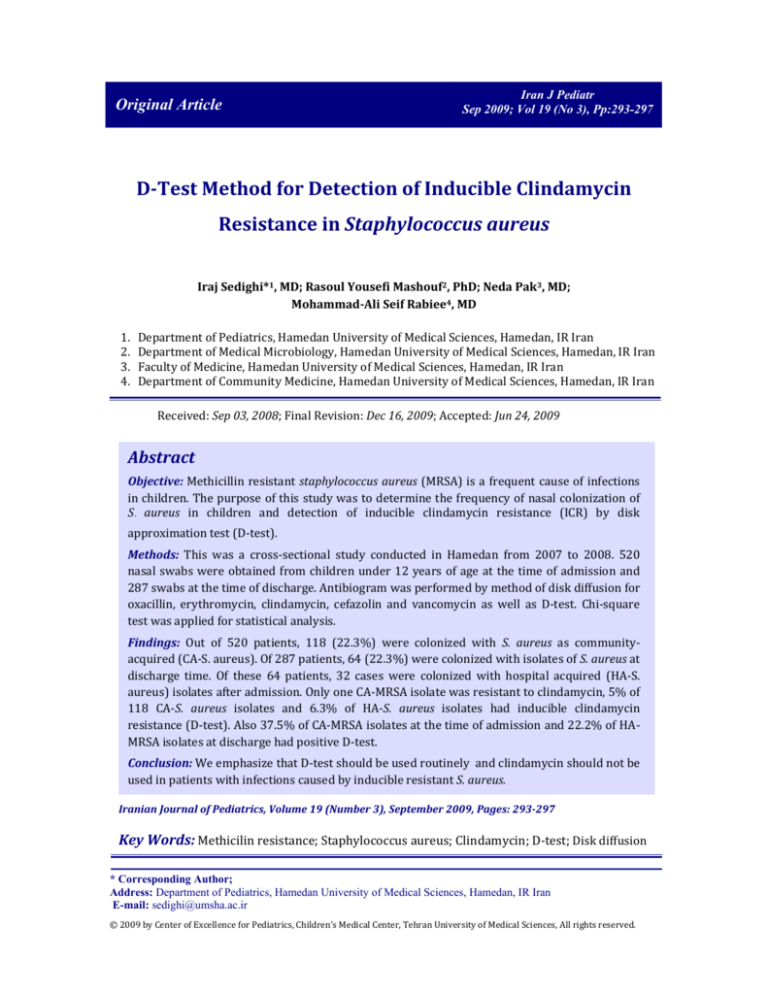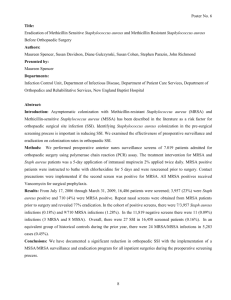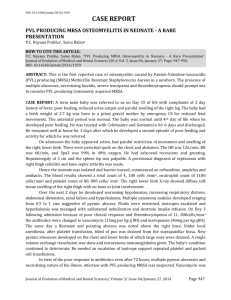
Iran J Pediatr
Sep 2009; Vol 19 (No 3), Pp:293-297
Original Article
D­Test Method for Detection of Inducible Clindamycin Resistance in Staphylococcus aureus Iraj Sedighi*1, MD; Rasoul Yousefi Mashouf2, PhD; Neda Pak3, MD; Mohammad­Ali Seif Rabiee4, MD 1.
2.
3.
4.
Department of Pediatrics, Hamedan University of Medical Sciences, Hamedan, IR Iran Department of Medical Microbiology, Hamedan University of Medical Sciences, Hamedan, IR Iran Faculty of Medicine, Hamedan University of Medical Sciences, Hamedan, IR Iran Department of Community Medicine, Hamedan University of Medical Sciences, Hamedan, IR Iran Received: Sep 03, 2008; Final Revision: Dec 16, 2009; Accepted: Jun 24, 2009 Abstract Objective: Methicillin resistant staphylococcus aureus (MRSA) is a frequent cause of infections in children. The purpose of this study was to determine the frequency of nasal colonization of S. aureus in children and detection of inducible clindamycin resistance (ICR) by disk approximation test (D‐test). Methods: This was a cross‐sectional study conducted in Hamedan from 2007 to 2008. 520 nasal swabs were obtained from children under 12 years of age at the time of admission and 287 swabs at the time of discharge. Antibiogram was performed by method of disk diffusion for oxacillin, erythromycin, clindamycin, cefazolin and vancomycin as well as D‐test. Chi‐square test was applied for statistical analysis. Findings: Out of 520 patients, 118 (22.3%) were colonized with S. aureus as community‐
acquired (CA‐S. aureus). Of 287 patients, 64 (22.3%) were colonized with isolates of S. aureus at discharge time. Of these 64 patients, 32 cases were colonized with hospital acquired (HA‐S. aureus) isolates after admission. Only one CA‐MRSA isolate was resistant to clindamycin, 5% of 118 CA‐S. aureus isolates and 6.3% of HA‐S. aureus isolates had inducible clindamycin resistance (D‐test). Also 37.5% of CA‐MRSA isolates at the time of admission and 22.2% of HA‐
MRSA isolates at discharge had positive D‐test. Conclusion: We emphasize that D‐test should be used routinely and clindamycin should not be used in patients with infections caused by inducible resistant S. aureus. Iranian Journal of Pediatrics, Volume 19 (Number 3), September 2009, Pages: 293­297 Key Words: Methicilin resistance; Staphylococcus aureus; Clindamycin; D‐test; Disk diffusion
* Corresponding Author;
Address: Department of Pediatrics, Hamedan University of Medical Sciences, Hamedan, IR Iran
E-mail: sedighi@umsha.ac.ir © 2009 by Center of Excellence for Pediatrics, Children’s Medical Center, Tehran University of Medical Sciences, All rights reserved. 294 Introduction Staphylococcus aureus is one of the most common human pathogens with ability to cause wide range of infections. Although healthy children have a small risk for serious infections, but they could be common carriers of this organism and many clinical infections may develop in nasal carrier individuals [1,2,3]. The incidence of invasive infections has been rising with emergence of community‐
acquired (CA) and hospital‐acquired (HA) methicillin‐resistant S. aureus (MRSA) [1,4]. Clindamycin is an alternative choice for mild to moderate MRSA infections especially in penicillin‐allergic patients. However, subinhibitory concentration of erythromycin is a common inducer of inducible clindamycin resistance (ICR)[1,5,6]. In Turkey it was detected that 5.7% of MRSA and 3.6% of methicillin‐sensitive S. aureus (MSSA) isolates had inducible clindamycin resistance and all erythromycin–resistant and clindamycin‐ susceptible MRSA isolates exhibited positive D‐test[7]. In another study in USA about 26% of clindamycin sensitive S. aureus isolates and 11% of MRSA isolates had inducible clindamycin resistance [8]. To detect inducible clindamycin resistance, there is a specific disk diffusion method that shows resistance is induced by erythromycin[1]. In this method an erythromycin disk is placed next to clindamycin disk. When erythromycin diffuses, induces resistance to clindamycin and results in flattening of the clindamycin zone of inhibition just next to the erythromycin disk, making a D shape, so this method is called D‐test. Our study estimates the frequency of D‐test among S. aureus isolates in nasal carrier children. Inducible Clindamycin Resistance in S. Aureus; I Sedighi, et al
December 2008. Method of sampling was not invasive and the proposal was approved by the research committee of the University. Informed consent was achieved from parents of the patients. No patients treated with antibiotics were included in the study. Nasal samples were collected by inserting a synthetic swab into both nostrils. 520 nasal swabs were taken from children at the time of admission and 287 specimens were also obtained at the time of discharge. The samples were coded and kept in transitional broth and sent to microbiology laboratory in Hamedan University of Medical Sciences. The samples were then transferred onto sheep blood agar and incubated at 35°C for 24‐48h. Catalase, DNase and coagulase assays were applied to identify isolates of S. aureus. Susceptibility testing was performed according to National Committee for Clinical Laboratory Standard on isolates of S. aureus by using the method of disk diffusion. Muller‐
Hinton agar and oxacillin, erythromycin, clindamycin, cefazolin and vancomycin disks (Mast UK and Padtan teb IR) were used to determine susceptibility of isolates. D‐test was also performed to asses ICR in Erythromycin‐
resistant clindamycin‐susceptible (ER‐R/CL‐S) isolates. This test was performed by placing an erythromycin disk in a distance of 15‐20mm of clindamycin disk. Demographic data and results of susceptibility tests were recorded in a special form and were analyzed by SPSS 13 software package. Chi‐square test was applied for statistical analysis. Findings Subjects and Methods This was a descriptive study conducted on 540 children aged 1 day to 12 years admitted to the pediatric ward of the university hospital of Hamedan, west of Iran, from February 2007 to From February 2007 for a period of 11‐
months all samples were collected. Demographic characteristics of our cases are shown in table 1. Out of 520 patients, 118 (22.3%) were colonized with community acquired S. aureus (CA‐ S. aureus) while 13.5% 295 Iran J Pediatr; Vol 19 (No 3); Sep 2009
Table1: Demographic characteristics of patients. Age <1 yr Female 31 Male 48 Total 79 1­3 yr 39 62 101 3­6 yr 26 36 62 6­9 yr 7 11 18 9­12 yr 8 19 27 Total 111 176 287 of them were MRSA isolates (CA‐MRSA). At discharge, 64 (22.3%) of 287 cases were colonized with S. aureus while 32 (13.7%) of them had been colonized after admission (HA‐
S. aureus). Out of 32 HA‐S. aureus isolates, only 3 (9.4%) were MRSA (HA‐MRSA). None of MRSA and MSSA isolates were resistant against vancomycin, only one CA‐
MRSA isolate was resistant to clindamycin. Resistance of CA‐MRSA and HA‐MRSA isolates were 33.3% and 66.7% against erythromycin, 11.1% and 0% against clindamycin, and 11.1% and 100% against cefazolin, respectively. Resistance of CA‐MSSA and HA‐MSSA isolates were 2.2% and 0% against erythromycin, however 100% of these isolates were sensitive to clindamycin and cefazolin (Table 2). In this study, 5% of CA‐S. aureus isolates and 6.3% of HA‐S. aureus isolates had positive D‐test. Also 37.5% of CA‐MRSA isolates at the time of admission and 22.2% of HA‐MRSA isolates had shown positive D‐test (Fig 1). Twenty‐four cases of 54 colonized patients with CA‐S. aureus isolates became non‐
colonized after admission while 16 (66.6%) of them were treated with antibiotics (P<0.001, chi‐square test). Discussion Nasal colonization with S. aureus is a significant risk factor for serious infections and in some situations elimination of S. aureus may reduce rate of subsequent invasive infections[9‐11]. For appropriate pediatric infection control, the prevalence of nasal Erythromycin
Flattening of zone of inhibition
Clindamycin
D shape
Fig 1: D‐Test. Erythromycin and clindamycin disks were placed in adjacent positions 296 Inducible Clindamycin Resistance in S. Aureus; I Sedighi, et al
Table2: The frequency of antibiotic resistance and positive D‐test of CA‐MRSA and HA‐MRSA isolates Antibiotic resistance CA­MRSA D­test
N (%) 6 (37.5) Clindamycin
N (%) 1(11.1) Erythromycin
N (%) 3 (33.3) Vancomycin
N (%) 0 (0.0) HA­MRSA 2 (22.2) 0 (0.0) 2 (66.7) 0 (0.0) carriage should be determined. In the present study the carriage rate of CA‐S. aureus was 22.3% while 13.5% of them were MRSA which is consistent with the results of another study which shows 18%‐38% nasal colonization[12]. Results of our study also indicated that 13.7% of non‐colonized cases were colonized following hospitalization (HA‐S. aureus) while 9.8% of them were MRSA. This is more than those reported from Srilanka in 2003 which showed 6% HA‐S. aureus after hospitaliza‐
tion[9]. Although clindamycin is an appropriate antimicrobial agent for treatment of mild to moderate CA‐MRSA infections, however, many of erythromycin‐resistant MRSA isolates have inducible clindamycin resistance that may lead to treatment failures. Some studies have indicated that approximately 45% of erythromycin‐resistant S. aureus isolates have inducible resistance[1]. We detected only oneCA‐MRSA isolate that was resistant to clindamycin while there were 5% and 6.3% positive D‐tests in S. aureus isolates (37.5% and 22.2% of MRSA isolates) at the time of admission and discharge respectively. Rahbbar and Hjia in another study in Iran demonstrated that 9.7% of staphylococci isolates had positive D‐test[13]. We have shown 6.3% incidence of ICR that is comparable with other studies in Turkey (9.7%) and Iran (5.7%)[7,13]. Accurate technique is important to select appropriate antibiotics; on the other hand disk diffusion method for clindamycin may demonstrate false susceptibility. However, clindamycin can be taken in patients with true clindamycin‐susceptible strains if ICR is excluded by an accurate method like D‐test. Our study was performed only in one hospital which may limit the validity of results and patients that were hospitalized in the same room might be colonized with the same organism. There is a potential for selection bias because patients in a better general condition had more possibility to participate in the study. Conclusion In the present study only one case was reported to be resistant to clindamycin, therefore, we recommend that clindamycin be used instead of vancomycin in mild to moderate diseases caused by CA‐MRSA to prevent resistance to our nearly last‐line drug (vancomycin). We described a simple, accurate method to detect inducible cindamycin resistance, therefore with respect to 37.5% of ICR we recommend: 1) to use D‐
test routinely in all microbiologic laboratories; 2) not to apply clindamycin in patients with infections caused by inducible resistant S.aureus; 3) to avoid switch therapy from erythromycin to clindamycin. Acknowledgment This study was funded and supported by the Deputy of Research Center of Hamadan University of Medical Sciences, Iran. The authors have no conflict of interest to declare. 297 Iran J Pediatr; Vol 19 (No 3); Sep 2009
We thank Mrs Zahra Heidar Barghi and staff of Microbiology Laboratory of Hamedan Medical University for their advice and assistance. 6.
In: Feigin RD, Cherry JD, Demmler GJ, Kaplan SL, ed. Textbook of Feigin Pediatric Infectious, Disease. Philadelphia: Saunders. 2004; Pp: 1118‐
23. 7.
Azap OK, Arslan H, Timurkaynak F, et al. Incidence of inducible clindamycin resistance in staphylococci: first result from Turkey. Clin Microbiol Infect. 2005;11(7):582‐4.
8.
Marr JK, Lim AT, Yamamoto LG. Erythromycin‐induced resistance to clindamycin in Staphylococcus aureus. Hawaii Med J. 2005;64(1):6‐8. 9.
Corea E, De Silva T, Perera J. Methicillin‐
resistant Staphylococcus aureus: prevalence, incidence and risk factors associated with colonization in Sri Lanka. J Hosp Infect. 2003;55(2):145‐8.
References 1.
Feibelcorn KR, Crawford SA, McElmeel ML, et al. Practical disk diffusion method for detection of inducible clindamycin resistance in Staphylococcus aureus and coagulase‐negative staphylococci. J Clin Microbiol. 2003;41(10):4740‐4. 2.
Di Modugno V, Guerrini M, Shah S, et al. Low level resistance to oleandomycin as a marker of ermA in staphylococci. J Antimicrob Chemother 2002;49(2):425‐
7. 3.
Drinkovic D, Fuller ER, Shore KP, et al. Clindamycin treatment of Staphylococcus aureus expressing inducible clindamycin resistance. J. Antimicrob. Chemother 2001;48(2): 315‐6. 4.
5.
10. Simor AE, Daneman D. Staphylococcus aureus decolonization as a prevention strategy. Infect Dis Clin North Am. 2009;23(1):133‐51. 11. Safdar N, Bradly EA. The risk of infection after nasal colonization with staphylococcus aureus. Am J Med. 2008; 121(4):310‐5. Frank AL, Marcinak JF, Mangat PD, et al. Clindamycin treatment of methicillin‐
resistant Staphylococcus aureus infections in children. Pediatr Infect Dis J. 2002;21(6):530‐4. 12. Erdenizmenli M, Yapar N, Senger S, et al. Investigation of colonization with methicillin–resistant and methicillin– susceptible Staphylococcus aureus in an outpatient population in Turkey. Jpn J Infect Dis. 2004;57(4):172‐5. Roberts MC, Sutcliffe J, Courvalin P, et al. Nomenclature for macrolide‐
lincosamide‐streptogramin B resistance determinants. Antimicrob Agents Chemother. 1999;43(12):2823‐30. 13. Rahbar M, Hajia M. Inducible clindamycin resistance in staphylo­
coccous aureus. Pak J Biol Sci. 2007;10(1):189‐92.






